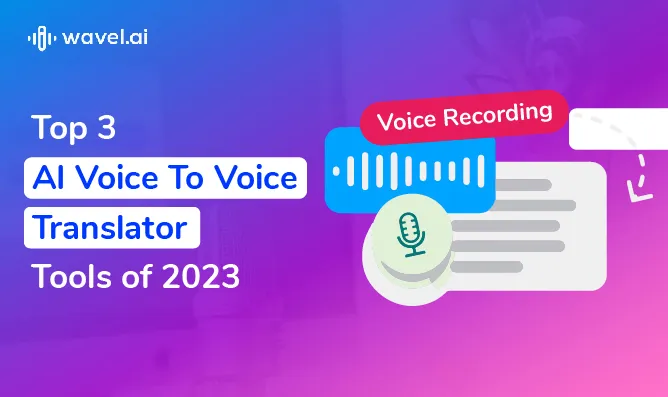AI Voice translation is the quickest way to consume any verbal content in your language. With the rapid advancements in AI, voice translation tools have also aced accuracy making them suitable for the masses.
These tools utilize AI algorithms to translate spoken language in real-time, enabling faster translation turnaround time for improved communication and content consumption. However, to get the best out of AI translation, you will need a tool that excels in this domain.
This article will take you through the top AI voice-to-voice translator tools you can prefer for personal or professional use. So, let’s get started!
What is an AI Voice Translator?
AI voice translators translate spoken language in real-time, allowing users to communicate verbally across language barriers. Such tools perform faster translation by utilizing AI and machine learning models for effortless translation. They can be called real-time interpreters, which can automatically recognize speech, process it, and store it in the language of your choice.
Top 3 AI Voice To Voice Translator Tools
AI voice to voice translation tools have revolutionized communication by enabling real-time language interpretation. Among all the voice translation tools, here are the top three options
- Wavel AI boasts advanced speech recognition and machine learning capabilities, offering accurate translations and facilitating smooth conversations across languages. It is more than a translation tool and offers a fair share of text to speech, voice cloning, and transcription capabilities.
- Maestra combines AI and natural language processing to deliver high-quality translations, enabling efficient and effective multilingual communication. These three AI-powered tools have significantly enhanced global interactions and bridged language barriers, catering to the needs of individuals, businesses, and organizations worldwide.
- Lastly, Smartcat is another prominent player, utilizes cutting-edge neural networks to provide seamless audio and video voice translations, ensuring clear and precise communication in various settings.
Let’s take a look at each one of them.
1. Wavel AI

Wavel AI is a cutting-edge voice-to-voice translator that has gained massive popularity due to its accuracy in translation. It leverages deep learning models and advanced natural language processing techniques to provide accurate and efficient translation services. Wavel AI supports over 70 languages, allowing users to communicate effortlessly across linguistic boundaries.
Main Features of Wavel AI
- Multi-language support: With support for numerous languages, users can converse in their preferred language, and the translation will be provided in real-time.
- High accuracy: The advanced AI models employed by Wavel AI ensure a high level of translation accuracy, minimizing misunderstandings and language barriers.
- User-friendly interface: Wavel AI offers a user-friendly interface, making it accessible to individuals with varying levels of technical expertise.
Wavel AI also offers a range of text to speech solutions, making it a comprehensive language tool. These features include subtitle generation, dubbing services, and voiceover capabilities, all powered by advanced AI algorithms.
Its text to speech solutions allow users to convert written text into spoken words using a diverse selection of over 250 AI voices across more than 70 languages.
More Than a Voice Translator
Subtitle Generation: Wavel AI’s subtitle generation feature enables users to add subtitles to videos or live presentations. The AI-powered system can generate synchronized subtitles in multiple languages by simply inputting the desired text. This feature is particularly useful for content creators, educators, and businesses looking to make their videos more accessible to global audiences.
Dubbing Services: Wavel AI’s dubbing services allow users to localize their content by replacing the original audio track with translated versions. Users can input the script or dialogue in their preferred language, and Wavel AI will generate a high-quality dubbed audio track naturally and fluently. This feature benefits filmmakers, media companies, and content creators seeking to expand their audience reach.
Voiceover Capabilities: With Wavel AI’s voiceover capabilities, users can convert written text into spoken words using a wide range of AI voices. Whether it’s for e-learning modules, audiobooks, commercials, or any other audio content, Wavel AI can provide professional and engaging voiceovers in multiple languages. Users can customize the voice characteristics such as tone, pitch, and speed to suit their specific requirements.
Use Cases
Being a tool with diverse voicing capabilities, Wavel AI caters to diverse use cases:
Global Communication: Wavel AI’s voice to voice translation and text to speech features enable seamless communication between individuals speaking different languages. It can be used in international business meetings, conferences, or even casual conversations while traveling, eliminating language barriers and fostering better understanding.
Content Localization: Wavel AI’s subtitle generation, dubbing, and voiceover services are invaluable for content creators looking to localize their videos, films, or multimedia presentations. By providing translations and alternative audio tracks, Wavel AI helps reach a broader audience and cater to diverse linguistic backgrounds.
Accessibility Enhancement: Wavel AI’s text to speech software contribute to improving accessibility for individuals with visual impairments or reading difficulties. By converting written content into spoken words, it facilitates access to information, educational materials, and entertainment for a wider range of users.
Language Learning: Wavel AI can be a valuable tool for language learners. With its real-time translation and voiceover capabilities, it allows users to practice their language skills in conversations or listen to professionally spoken content in their target language. It provides an immersive and interactive language learning experience.
Media Production: Wavel AI’s dubbing and voiceover services are particularly useful for media production companies. It enables them to efficiently create localized versions of their content, saving time and resources. The diverse range of AI voices also provides flexibility in selecting the most suitable voice for different projects.
Verdict: Wavel AI is an impressive voice-to-voice translator with its robust real-time translation capabilities and multi-language support. It is well-suited for individuals seeking quick and accurate translations during conversations.
2. Maestra

Maestra is a versatile AI voice-to-voice translator tool that has gained popularity due to its comprehensive features and ease of use. It utilizes advanced machine learning algorithms to deliver accurate translations, making it a valuable asset for multilingual communication.
Main Features Of Maestra
- Collaboration Capabilities: Maestra offers collaboration tools, allowing multiple users to engage in conversations and share translations simultaneously.
- Integration capabilities: The platform doesn’t clearly states its integration capabilities. That means its hard to tell whether it can integrate with video conferencing tools and messaging apps, for improved accessibility.
- Post-editing options: It allows users to make post-editing translation adjustments, ensuring greater accuracy and fluency.
Verdict: Maestra is an adaptable voice-to-voice translator tool, handy for users who require real-time transcription alongside translation. Its collaborative features make it a compelling choice for team communication.
3. Smartcat

Smartcat is another AI voice-to-voice translator tool powered by state-of-the-art neural networks. It offers reliable translation services with a focus on accuracy and fluency. It provides a seamless experience for users by enabling smooth communication across languages.
Main features of Smartcat
- Neural network-powered translation: Smatcat is another translation tool that utilizes advanced neural networks to ensure accurate and natural-sounding translations.
- Contextual understanding: Smartcat’s AI algorithm grasps context well, allowing for more precise translations that capture the intended meaning.
- Voice recognition: It is backed by voice recognition capabilities, which accurately capture spoken input and produce high-quality translations.
- Language customization: Users can personalize their translation experience by customizing specific language preferences and dialects.
Verdict: Smartcat stands out for its AI powered translation, contextual understanding, and customizable language preferences. It is suitable for individuals seeking accurate and natural translations. However, it is a pricy tool for its limited voicing features.
A Table of Comparison
| Translation Platform | Main Features | Best For | Pricing |
| Wavel AI | Real-time translation capabilities. Support for multiple languages | Businesses, professionals, individuals | A lifetime free plan. Premium plans start just from $18 per month |
| Maestra | Automatic transcription and translation | Content creators, journalists, researchers | There is no free plan. Pay-as-you go costing $10/hour of transcription/translation |
| Smartcat | AI translation, Website translation | Individuals, small businesses | No free plan. Premium plans: starting from $99/month |
Choose the Best Translation Tool
We have witnessed remarkable advancements in AI voice-to-voice translation tools. Among all the AI tools in the market, Wavel AI has emerged as top contender for its extended range of voicing options.
It stands out with its cutting-edge technology, real-time translation capabilities, multi-language support, high accuracy, and additional text-to-speech solutions. Its user-friendly interface makes it accessible to users with varying technical expertise. The best part?
You can use the tool for free and test all its features before committing to the service.
Frequently Asked Questions
A: An AI voice to voice translator tool is a software application that utilizes artificial intelligence techniques to convert spoken language from one language to another in real-time. It allows users to have a conversation with someone who speaks a different language by automatically translating their speech.
A: AI voice to voice translator tools typically use automatic speech recognition (ASR) technology to convert the spoken language into text, and then machine translation algorithms to translate the text into the desired language. Finally, the translated text is converted back into speech using text-to-speech (TTS) synthesis, allowing the recipient to hear the translation.
A: Wavel AI’s Voice to Voice Translator supports a wide range of languages, including but not limited to English, Spanish, French, German, Chinese, Japanese, Korean, Italian, Portuguese, and Russian. The exact list of supported languages may vary, so it’s advisable to check the latest documentation or website for an up-to-date list.
A: Wavel AI’s Voice to Voice Translator is designed to handle various types of sentences, including complex ones. However, its ability to accurately translate specialized vocabulary or domain-specific terminology may vary depending on the language pair and the available training data. In some cases, there may be limitations in accurately translating highly technical or niche content.
A: Yes, Wavel AI’s Voice-to-Voice Translator tool is designed to be versatile and accessible. It is available as a standalone mobile application for both iOS and Android devices. Additionally, it may also be integrated into other platforms or devices through APIs, allowing developers to incorporate the translation functionality into their own applications or products.

.webp)






